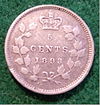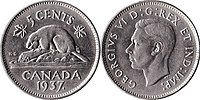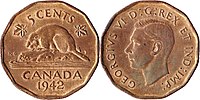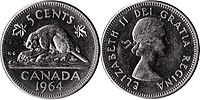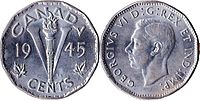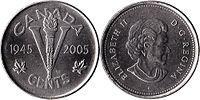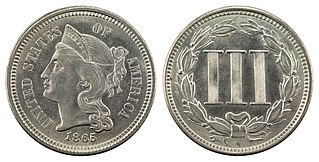Canada | |
| Value | 0.05 CAD |
|---|---|
| Mass | 3.95 g |
| Diameter | 21.2 mm |
| Thickness | 1.76 mm |
| Edge | smooth (plain) |
| Composition | Nickel-plated steel 94.5% steel, 3.5% Cu, 2% Ni plating |
| Years of minting | 1858–present |
| Catalog number | – |
| Obverse | |
 | |
| Design | Elizabeth II, Queen of Canada |
| Designer | Susanna Blunt |
| Design date | 2003 |
| Design discontinued | 2023 |
| Design | Charles III, King of Canada |
| Designer | Steven Rosati |
| Design date | 2023 |
| Reverse | |
 | |
| Design | Beaver sitting on a rock |
| Designer | G.E. Kruger Gray |
| Design date | 1937 |
The Canadian five-cent coin, commonly called a nickel, is a coin worth five cents or one-twentieth of a Canadian dollar. It was patterned on the corresponding coin in the neighbouring United States. It became the smallest-valued coin in the currency upon the discontinuation of the penny in 2013. Due to inflation, the purchasing power of the nickel continues to drop and currently the coin represents less than 0.5% of the country's lowest minimum hourly wage.[ as of? ][ citation needed ]
Contents
- History
- 1921 five-cent coin
- Types and specifications
- Commemorative nickels
- Mintage
- See also
- References
- External links
The denomination (i.e., the Canadian five-cent piece) had been introduced in 1858 as a small, thin sterling silver coin, that was colloquially known as a "fish scale", not a nickel. The larger base metal version made of nickel, and called a "nickel", was introduced as a Canadian coin in 1922, originally as 99.9% nickel metal. These coins were magnetic, due to the high nickel content. Versions during World War II were minted in tombac (a copper-zinc alloy), then chrome and nickel-plated steel, and finally returned again to nickel at the end of the war. A plated steel version was again made from 1951 to 1954 during the Korean War. Rising nickel prices eventually caused another switch to cupronickel in 1982 (an alloy similar to the US nickel), but more recently, Canadian nickels are minted in nickel-plated steel, containing a small amount of copper. Due to the aforementioned rise in nickel prices, since 1982, five-cent pieces composed of 99.9% nickel have been slowly removed from circulation to be melted by the Royal Canadian Mint. Only cupronickel and modern multi-ply plated steel five-cent pieces are considered "circulation coins". [1] As a result, pre-1982 five cent pieces are often sought by collectors.
From 1942 to 1962, Canadian five-cent coins were produced in a distinctive 12-sided shape, evocative of the British threepence coin. Originally this was done to distinguish the copper-coloured tombac coins, from pennies. However, the characteristic shape was retained for another eighteen years after 1944 when this coin was later produced in 99.9% nickel and chrome-plated steel.
The coin is produced by the Royal Canadian Mint at its facility in Winnipeg.
